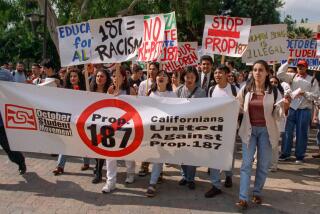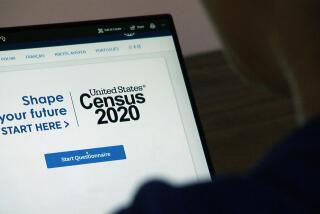The Changing Census
- Share via
America is a country so unsettled about race that almost every census since colonial times has measured it differently, both mirroring and magnifying the biases of the age.
When the census originated in the late 18th century, the nation was still part slave and part free, and preoccupied with the notion of ownership. In 1790, it categorized its citizens as free white males, free white females, other free people and slaves.
In the 19th century, the issue of miscegenation took center stage, so the census precisely tracked the bloodlines that came from intermarriage. People in 1890 were counted as white, black (if they had three-quarters or more black blood), mulatto (three-eighths to three-fifths black), quadroon (one-quarter) or octoroon (one-eighth).
By the 1930s, the so-called “one-drop” rule held sway, when common practice and several court rulings said any person of mixed black and white descent is considered black. Or as the Census Bureau told its enumerators that year, “A person of mixed white and negro blood is to be returned a negro no matter how small the percentage of negro blood.” Another key change in census procedure, and one that helped fuel the movement for self-definition among people of mixed race, came in the 1960s when respondents for the first time decided which box to check themselves, rather than being visually identified by door-to-door census-takers.
This was also the decade when Latinos gained a place on the form. Mexicans had been counted in the 1930s, then were dropped from the census count. But in the 1960s, the Census Bureau asked people to note if they were of Hispanic origin. This is an ethnic, not a racial, category and is counted separately on the census form. Thus it engenders particular confusion. In California, for example, about half of all Latinos describe themselves as something other than white on census forms; many consider themselves mestizo--of mixed Spanish and American Indian parentage--while others identify themselves as blacks or Asians. The vast majority of people who check “other” on census forms, in the state and across the nation, are Latinos, apparently objecting to choices that do not reflect their racial diversity.
Even as these categories were designed, they were under siege. First came 1965 changes in immigration law that opened America’s doors to more Latinos and Asians. Then followed a 1967 Supreme Court ruling (Loving vs. Virginia) that struck down the nation’s 16 remaining miscegenation laws and swelled the number of intermarriages and interracial births.
More to Read
Get the L.A. Times Politics newsletter
Deeply reported insights into legislation, politics and policy from Sacramento, Washington and beyond. In your inbox twice per week.
You may occasionally receive promotional content from the Los Angeles Times.










